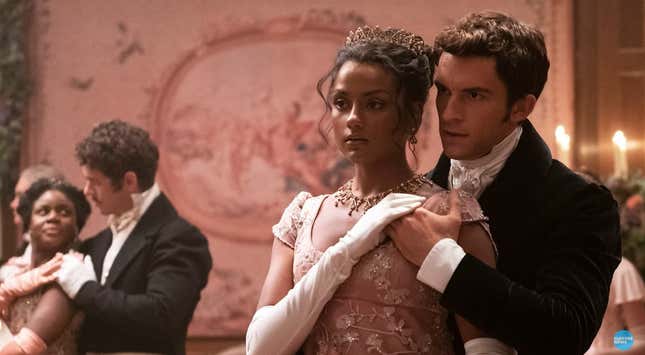‘Bridgerton’ Season 2 Looks Toxic as Hell, So Brace Your Bustiers
The love triangle between Anthony, Edwina, and Kate already has me throwing a hard side-eye.
EntertainmentTV

This week, Lady Whistledown and Her Majesty Queen Charlotte invited frenzied fans and friends of the Bridgerton court to join them for the momentous virtual red carpet soiree to view the new Season 2 trailer. “You wouldn’t want to disobey the Queen’s orders,” warns Queen Charlotte.
Like many Bridger-buffs who have read all the books, I was front and center for the premiere. But all the sneak peaks of the plot, scenes, and Season 2 predictions have fallen short for me—and apparently many other BIPOC audience members on the internet. This season features the oldest Bridgerton, Anthony (Jonathan Bailey), on a quest to find a “suitable wife,” and new-to-town sisters Edwina Sharma (Charithra Chandran) and Kate Sharma (Simone Ashley) seem intriguing. The broken-hearted Anthony, a former rake, is desperate to find a match by any means necessary after his on-again, off-again lover Siena finally distanced herself from his antics last season. Anthony is now positioned as a tortured soul, stuck in a “complicated” love-triangle with two sisters.
All I can do is roll my eyes. I’ll admit we love to see two women of color as the leads, but I fear the Shondaland team is setting us up for a repeat of Season 1’s problematic nods and shoulder shrugs to race. Don’t get me wrong: Were Anthony’s skirt-hiking, bodice-ripping love scenes with Siena super hot? Yes. One of the best things about Regency Era shows like Bridgerton is watching corsets and cummerbunds fly in titillating romps of ecstasy, wondering if he’ll be able to unlace her bustier before he bust-i-ays all over her blouse. No one likes to see a duke on his knees in a staircase cunnilingus scene more than I do, but, oh, Bridgerton, Lord Bridgerton… this isn’t it.
Numerous film critics have called out Bridgerton for its sloppy mishandling of race and social class since it was first released. Past critiques have explored points of colorism, “color blind” vs. color-conscious casting, and the show’s issue with featurism. Show-runner Chris Van Dusen responded to the color blind casting criticism by saying: “I don’t call the casting color blind, because I feel like the word color blind implies that color and race was never considered — and I don’t think that’s true for Bridgerton.” But a show in which actors of color are deliberately cast into white roles, like Hamilton, must go beyond simple consideration of color and race and take care to make sure the characters of color aren’t being tokenized. Simply put, make it make sense, Van Dusen.
Instead of an ambiguous and passé approach to acknowledging race, here’s what the BIPOC audience wants to see and deserves from future seasons:
1) No casting of new people of color unless they plan to follow through with expansive recognition and real conversations around race.
-

-

-

-

-

-

-

-

-

-

-

-

-

-

-

-

-

-

-

-

-

-

-

-

-

-

-

-

-

-

-

-

-

-

-

-

-

-

-

-








































